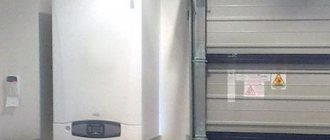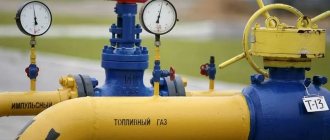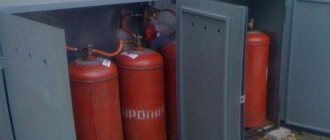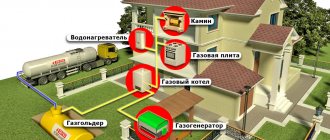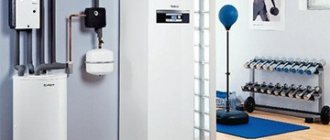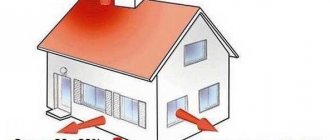When designing a heating system for a home, owners are required to know in advance how much it will cost to heat their living space during operation. Ultimately, it may be that the heating system will simply be unprofitable if the equipment is chosen incorrectly, the design is poorly designed, or the walls are poorly insulated. Therefore, it is important to correctly calculate the gas consumption for heating a house of 200 m2. From the obtained figure you can already start and start or not start designing and purchasing equipment.
Determination of boiler power
When calculating the consumption of liquefied gas for heating a house of 200 m2, the boiler power is first determined. It is assumed that for every 10 square meters of heating area, 1 kW of power is needed. Based on the fact that the value needs to be divided in half, we take half - this is 50 watts per hour per square meter. For 100 meters of area we need 5 kW of power; at 200 meters - 10 kW. This means that when choosing a heating boiler, we need to look for models with a power of 12-15 kW. It is recommended to choose equipment with a reserve. If you choose a 10 kW boiler, then it should cope with its task, but if somewhere the heat loss in the house is higher than expected, then the boiler will work at the limit of its capabilities and will not always be able to provide proper heating.
Propane use
The substance has the formula C3H8 and belongs to the low-toxic category with a specific odor. Air becomes explosive if it contains a concentration of butane vapor of 1.8 - 9.1%, propane - 2.3 - 9.5%, the pressure is 0.1 MPa at a temperature of +15 to + 20 ° C. Propane ignites spontaneously at +470°C, butane – +405°C.
Chemical and physical properties of propane:
- molecular weight – 44.097 kg/kmol, molecular volume – 21.997 m3/kmol;
- liquefied gas consumption per 1 kW of heat is 0.16 dm3 (liter);
- gas density at 0°C – 2.0037 kg/m3, at +20° – 1.87 kg/m3;
- density in the liquid phase – 528 kg/m3;
- the volume of air required for combustion of 1 cubic meter is 23.8 m3.
Centralized gas pipeline
The gas pipeline supplies natural gas. The construction of a centralized pipeline requires certain costs, so methane is used by residents of densely populated regions and areas with large volumes of consumption. The suburban population does not always have access to a gas pipeline and fuel is delivered to them in cylinders.
The main line is built from steel pipes with a diameter of up to 1.42 m and is designed for pressure up to 10 MPa. The pipelines carry about 55–60 billion cubic meters of gas per year. Highways are laid underground or on the surface. The comprehensive service includes compressor points, cleaning and drying stations, and gas distribution points.
Gas tanks
Gas tanks
For continuous supply of LPG, underground and above-ground gas tanks are used, which are installed in a multi-storey sector or on the territory of a private housing estate. From the tank, fuel is supplied to apartments and houses and used to heat the room.
Gas tanks have a monitoring system and record the filling of the sump. The sensor determines the gas reserve and transmits a signal to the service when the fuel level in the tank decreases to 30%. The operator sends a tanker to fill the tank.
Liquid that has not turned into a gaseous state constantly accumulates at the bottom of the gas tank; the tank requires cleaning. The storage facilities are convenient to use because they provide a continuous supply of fuel.
Cylinders
Bottled gas is used for home heating if residents do not regularly visit their country house in winter. Propane or its mixture with butane is supplied in containers. The downside is the increase in fuel costs when moving away from the product supplier. A standard propane tank holds 22 kg of gas and weighs 19 kg. Composite containers are used, they are lighter, but more expensive.
Gas cylinder parameters:
- unit length 28 – 95 cm;
- diameter – 20 – 30 cm;
- wall thickness – 3 – 4 mm;
- weight – 4 – 22 kg.
Forum natural gas consumption for heating a 200 m2 house
There is a special formula by which the calculation must be carried out:
A = Q / q * B.
In this formula:
- A is the amount of gas per hour to be determined.
- Q is the power required for heating (in our case it will be equal to 10 kW).
- q is the minimum specific heat. This parameter depends on the brand of gas used. If your gas pipeline uses G20 gas, then this value will be equal to 34.02 MJ/cubic meter. It must be converted into kilowatts using the formula: 1 MJ = 0.277(7) kWh. It will be equal to 9.45 kWh.
- B is the efficiency of our equipment. The value depends on the boiler you choose. There are models on the market with efficiency ratios of 80%, 90%, 95%, 98%. It is advisable to select a boiler with a higher efficiency. This way, the gas consumption for heating a house of 200 per m2 will be less, and the savings over the year will be significant. For at least a few years, the savings will exceed the costs of the higher cost of a high-efficiency boiler. Let's say you choose a model with 95% efficiency. However, we cannot put percentages in the formula. Therefore, we take the coefficient 0.95 and use it.
We know all the numbers. Now you just need to substitute them into the formula:
A = 10 / 9.45 * 0.95 = 1.0053 cubic meters m/hour.
This means that the average gas consumption for heating a 200 m2 house is 1 cubic meter per hour. But this is provided that you use a boiler with an efficiency of 95%, and your gas pipeline contains G20 gas. Otherwise, the values in the formula need to be changed, the result will be slightly different.
Calculation of liquefied gas
The above formula will also work for liquefied gas. The only difference is the different thermal conductivity of the gas itself. Therefore, here the parameter q is taken equal to 46 MJ per kilogram or 12.8 kW per kilogram. Let's leave the boiler efficiency equal to 95. Substitute the values into the formula and get:
A = 10 / 12.8 * 0.95 = 0.74 kg/hour.
Liquefied gas is always counted in kilograms. The value is then converted to liters. To do this, the resulting value must be divided by 0.54. In our case, the consumption is 1.37 liters of gas per hour. Next, according to the usual scheme:
- The daily consumption of liquefied gas will be 33 liters.
- Monthly consumption is almost a thousand liters.
It is worth considering that a standard cylinder contains only 42 liters. This bottle lasts for about a day. To understand how many cylinders we need, simply divide the amount of gas per season by 42. Next, knowing the cost of a cylinder of liquefied gas, you can calculate how much it will cost to heat a house.
However, it is not necessary to buy cylinders. You can use a gas holder. Gas consumption for heating a house of 200 m2 in this case will not differ. Simply pumping a large volume of gas into a gas tank for a whole season at once will be more profitable than buying a large number of cylinders.
Reducing consumption
This is known: if you insulate your house well, the fuel consumption for heating will be significantly reduced. Therefore, before selecting and installing equipment and laying main routes, it is necessary to properly insulate the house: walls, roof and attic, floor, replace windows, and make an airtight sealing loop on the doors.
Particular attention should be paid to the roof and windows. It is assumed that out of 100% of lost heat, 35% goes through the roof, about 25% is lost at the windows. Therefore, use the best thermal insulation materials and good double-glazed windows, which have a low thermal conductivity coefficient. Cheap double-glazed windows are immediately obvious: their aluminum or steel “skeleton” is always very cold in winter, and a lot of heat is lost directly through it. Even the glass itself does not transmit heat as much as the metal profile on which the glass is held does.
Warm floor or conventional radiators
Also, the correct heating design plays an important role. It is estimated that a well-designed and implemented heated floor will reduce gas consumption. Conventional radiators would require more gas to heat indoor air to the same level. This is due to the fact that thanks to a warm floor, heat rises from bottom to top and spreads throughout the entire area of the room. But conventional batteries heat the outer wall, which is why their efficiency is lower.
Also, the standard floor temperature is 50 degrees, the radiator is 90 degrees. Obviously, the floors will be more efficient and economical. Yes, the project and installation of flooring will cost more, but the difference in price will pay off very quickly.
How to pay less
Since you won’t be able to significantly win in price by installing autonomous heating, you need to turn to energy-saving technologies.
- Carry out thorough insulation of not only the walls of the building, but also the roof, floor, foundation, even the basement, if there is one.
- Replace double-glazed windows with energy-saving ones, the profile is frost-proof.
- Install a boiler with maximum efficiency and an electronic thermostat.
- Check the condition of the house's thermal insulation using a thermal imager to identify cold spots and eliminate them.
- Change the ventilation and air conditioning system. Just an open vent or a window set for ventilation takes in more heat than a window opened for 5-7 minutes and a complete change of air in the room.
- Install heated floors, especially in hallways and hallways.
- Install electronic sensors on radiators to block heating above the set temperature.
It is very effective to use the smart home system, which will reduce gas consumption by at least 25%. If you follow all the tips, your home will be warm and cozy, and your gas bills won’t be terrible.
The smart home system is easier and more comfortable to control using a remote controlSource archidom.ru
We use modern automation
Well, and the obvious things: you can save gas by correctly setting the heating time. For example, if you are away from home from morning to evening, then in the boiler (if it supports such a function) you can set the thermostat to a low temperature and program an increase in power at a certain time. And if you are away from home for weeks or even months, then ideally you need to set the coolant temperature to 3-5 degrees. And let it be cold in the house. The main thing is that the pipes do not freeze.
Modern technologies have gone far ahead in this regard. Many boilers can be equipped with modern automation, which allows you to control the device remotely. You can command the boiler to change mode from your smartphone while at work. For this purpose, special GSM modules are installed on the equipment. And there are many similar smart systems. If used correctly, actual heating costs can be reduced. Sometimes savings can reach 30, 40 and even 50%. Of course, this depends on how often you are at home and what the temperature is outside.
How to pay less
Since you won’t be able to significantly win in price by installing autonomous heating, you need to turn to energy-saving technologies.
- Carry out thorough insulation of not only the walls of the building, but also the roof, floor, foundation, even the basement, if there is one.
- Replace double-glazed windows with energy-saving ones, the profile is frost-proof.
- Install a boiler with maximum efficiency and an electronic thermostat.
- Check the condition of the house's thermal insulation using a thermal imager to identify cold spots and eliminate them.
- Change the ventilation and air conditioning system. Just an open vent or a window set for ventilation takes in more heat than a window opened for 5-7 minutes and a complete change of air in the room.
- Install heated floors, especially in hallways and hallways.
- Install electronic sensors on radiators to block heating above the set temperature.
It is very effective to use the smart home system, which will reduce gas consumption by at least 25%. If you follow all the tips, your home will be warm and cozy, and your gas bills won’t be terrible.
The smart home system is easier and more comfortable to control using a remote controlSource archidom.ru
